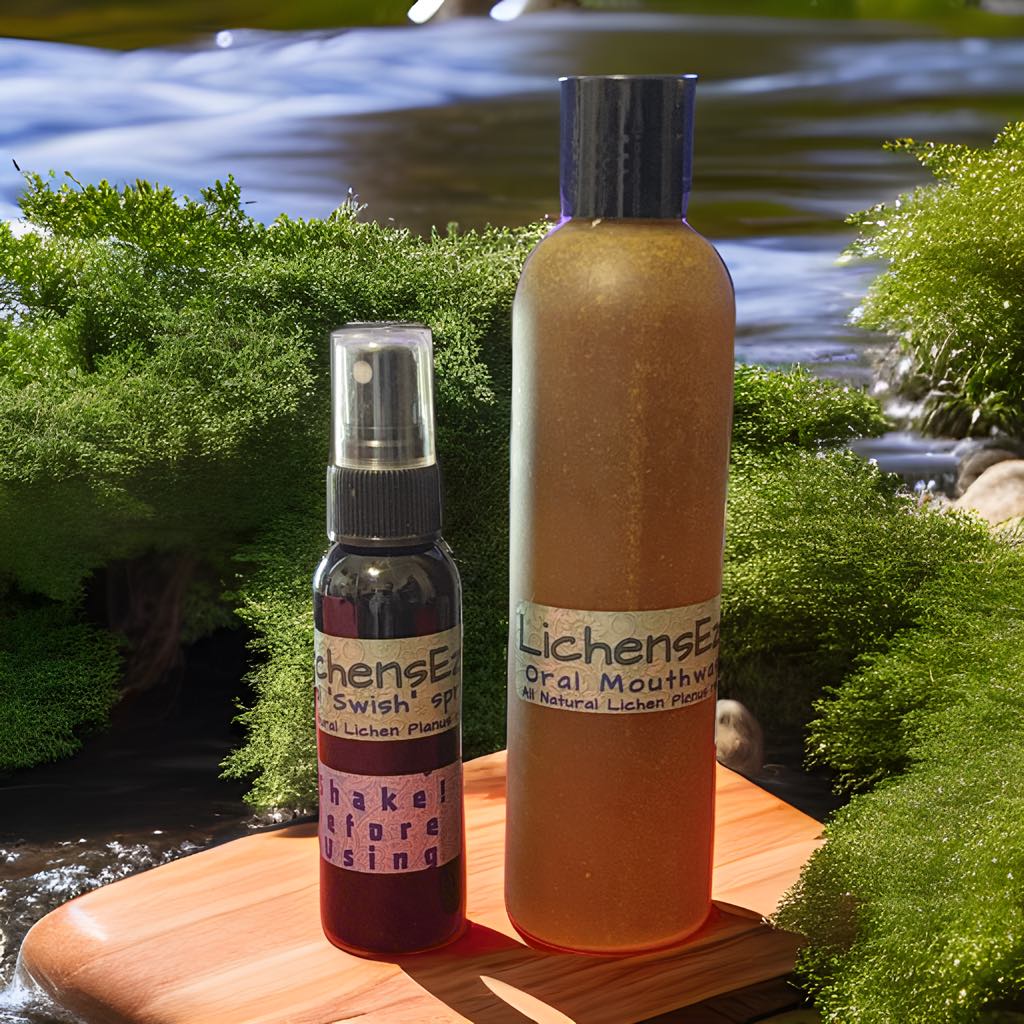
Oral Lichen Planus: Causes, Diagnosis, and Effective Treatments
Share

Oral lichen planus is a chronic condition that affects the lining inside the mouth. People might notice white patches, red areas, or painful sores that make eating and speaking tough.
Understanding oral lichen planus matters, since some cases can raise the risk of other health problems—including mouth cancer (learn more).
People often wonder what actually causes oral lichen planus and how doctors diagnose it. They seem to be leaning towards a connection with delayed onset rash to a viral infection.
Treatment options and natural alternatives like LichensEze come up a lot for folks searching for relief.
Key Takeaways
- Oral lichen planus affects the mouth and can be uncomfortable.
- Triggers include immune responses, medications, and other factors.
- Several treatment options and natural alternatives exist.
Understanding Oral Lichen Planus
Oral lichen planus (OLP) is a long-term condition that targets the mouth. Sometimes, it even shows up on the skin.
It usually causes white patches and can make eating or talking pretty unpleasant.
What Is Oral Lichen Planus?
Oral lichen planus (OLP) is a persistent inflammatory disease that attacks the mucous membranes inside the mouth. The immune system gets confused and starts targeting the mouth’s lining.
It’s not infectious, so you can’t catch it from someone else. Symptoms tend to come and go, sometimes getting worse or better for no clear reason.
The classic sign? White lines or lace-like patterns called Wickham’s striae. You’ll usually spot these on the inside of the cheeks, tongue, or gums. For more details, check the Mayo Clinic overview of oral lichen planus.
Who Is Affected
Oral lichen planus shows up in adults of any age, but middle-aged and older people get it most often. It affects about 1% to 2% of the population.
Kids rarely get it. People with other autoimmune diseases, thyroid issues, or hepatitis C face a higher risk. Occasionally, OLP pops up on the skin, genitals, or nails, but that’s less common.
The disease sticks around for years, with symptoms flaring up and calming down unpredictably. More stats and info on affected groups are in this review article.
Common Symptoms
The symptoms of oral lichen planus can really differ from person to person. The most common signs are:
- White, lace-like patterns (Wickham’s striae) on the inner cheek, tongue, or gums
- Red, swollen, or sore patches that might hurt
- Burning or sensitivity, especially with spicy, acidic, or hot foods
- Ulcers or open sores that can bleed or get infected
Many people feel discomfort or a burning sensation while eating or brushing, especially with the erosive type. Some folks only have mild issues, while others deal with severe pain or even gingivitis if the gums get involved.
Symptoms tend to come and go, sometimes sticking around for years. For more, see this oral lichen planus patient guide.
Types and Variants
Oral lichen planus comes in a few main types, each with its own look. The six most common are:
- Reticular: Thin, white web-like lines (Wickham striae)
- Erosive: Red, inflamed, and painful spots with ulcers
- Plaque-like: Thick, raised white patches
- Atrophic: Red areas surrounded by white lines
- Papular: Small, raised white bumps that sometimes merge
- Bullous: Fluid-filled blisters that break easily, leaving sore spots
Reticular is the most common—those classic white lines on the cheeks. Erosive types hurt more and can cause burning. Sometimes, just the gums get hit, known as desquamative gingivitis.
Knowing which type you have helps guide treatment. More on classification is in this overview of oral lichen planus types.
Causes and Risk Factors
Oral lichen planus is a complicated beast with several possible causes. Research suggests that both the immune system and certain health issues can raise your risk.
Immune System Involvement
Most experts think the immune system mistakenly attacks cells in the mouth. T-cells, a kind of white blood cell, stir up inflammation and create those white patches.
Autoimmune diseases, like lupus or pemphigus vulgaris, sometimes show up alongside oral lichen planus. When these overlap, it hints at bigger immune regulation issues. This immune attack leads to discomfort and damage over time, so treatments often aim to calm things down.
Environmental Influences
Exposure to certain medicines, dental materials, or infections can make symptoms worse. Even dental plaque, mouth injuries, or dental work- including a standard cleaning might trigger problems for some people.
Some chemicals in dental fillings, like amalgam, noble metals, or implants, can trigger or worsen spots that look a lot like oral lichen planus. Cutting down on these triggers can help manage the condition.
Associated Conditions
Certain infections and diseases show up more in people with oral lichen planus. Researchers are looking at a possible link between lichen planus and newly discovered HHVs- they think there is a possibility that lichen planus is to HHV6 and or 7 what shingles is to chickenpox.
Potential Triggers
Everyday habits or exposures can sometimes set things off. Stress is a big one—lots of people notice symptoms get worse when they’re stressed out.
Injuries to the mouth, like biting your cheek or dental work, can also play a part. Even common infections may trigger or intensify symptoms.
Some medications, like NSAIDs, beta-blockers, or certain blood pressure drugs, have been known to trigger or worsen oral lichen planus. Reactions to dental materials may be involved, too. Figuring out and avoiding your personal triggers can really help with flare-ups.
Diagnosis and Clinical Assessment
Getting the diagnosis right is key, since oral lichen planus can look like a bunch of other mouth problems. Dentists and dermatologists check the mouth, run tests, and sometimes take tissue samples to confirm things. We always recommend a biopsy.
Steps in Diagnosis
Diagnosis usually starts with a medical history and a close look in the mouth. Providers look for telltale signs like lace-like white lines (Wickham’s striae), red spots, or ulcers.
These patches often show up on the inner cheeks, tongue, and gums, and they usually hit both sides. Dentists or dermatologists will ask about recent meds, dental work, and allergies, since those can cause similar reactions.
They’ll also check for health issues linked to immune problems. Sometimes, extra tests like immunofluorescence help if the case isn’t obvious. These tests look for certain immune patterns in the tissue.
Biopsy and Histopathology
If the diagnosis is still unclear, the dentist might take a small biopsy from your mouth. They numb the area, remove a tiny bit of tissue, and send it to the lab.
The pathologist looks for things like band-like lymphocytic infiltrate under the surface, destruction of the basal cell layer, and hyperkeratosis (thickened keratin). Sometimes, they’ll do direct immunofluorescence to check for immune proteins or cells.
Histopathology helps confirm the diagnosis and rule out other diseases. Getting this right matters, since similar-looking conditions can need totally different treatments.
Distinguishing from Similar Conditions
Oral lichen planus can mimic other issues, like oral lichenoid lesions, leukoplakia, lupus, or even early oral cancer. Diagnosis isn’t always easy because features overlap and things change over time.
| Condition | Key Features |
|---|---|
| Oral Lichen Planus | Symmetrical, lace-like patterns, persistent lesions |
| Lichenoid Drug Reaction | Related to medicine use, often localized |
| Leukoplakia | Thick white patches, not lace-like, can vary |
| Lupus Erythematosus | Oral and skin findings, immune markers may help |
Doctors use a mix of your history, exam, biopsy, and sometimes broader tests to rule out other diseases. Staying in touch with a dentist or dermatologist helps keep an eye out for changes or complications.
LichensEze Natural Alternative
LichensEze offers a gentle, natural oral lichen planus treatment for folks who'd rather skip steroids. It relies on food-grade ingredients, making it a safer pick for sensitive mouths and everyday use.
The formula includes soothing elements that help with irritation, redness, and burning. People often notice less itching and discomfort after using it regularly.
The cream skips harsh chemicals and artificial dyes. Many people lean toward this kind of alternative when managing chronic mouth conditions—can you blame them?
Key features of LichensEze:
- Contains only natural ingredients
- Steroid-free and chemical-free
- Aims to soothe mouth lesions and ulcers
Here's a quick table of benefits:
| Feature | Benefit |
|---|---|
| Food grade formula | Safe for oral tissue |
| Plant-based oils | Help reduce irritation |
| No added steroids | Less risk of side effects |
If you're looking for safe relief from oral symptoms, it might be worth trying a natural solution for oral lichen planus. LichensEze gives you a gentle way to manage discomfort, burning, and soreness.
You can use it alongside your regular care steps for a bit of extra comfort. This natural alternative feels like a simple, soothing option for anyone hoping to keep oral lichen planus under control.
Frequently Asked Questions
Oral lichen planus is a long-lasting problem that affects the inside of the mouth. It can cause discomfort and changes in how your mouth looks.
You'll need to keep an eye on it for any serious changes.
What are the common treatment options for managing symptoms?
Doctors usually prescribe topical corticosteroids for the affected area. In tougher cases, you might get steroid mouth rinses or stronger medicines like tacrolimus or cyclosporine.
Good oral hygiene, avoiding spicy foods, and managing stress can help control symptoms. You can find more details from the Cleveland Clinic.
How can you tell if Oral Lichen Planus might be developing into cancer?
Erosive types of oral lichen planus carry a small risk of turning into mouth cancer. Watch out for persistent sores, thickened areas, or ulcers that just won't heal.
It's smart to have regular dental checkups to catch changes early, especially if you see red or white patches that look new or different. The Mayo Clinic has more info if you're curious.
What do the typical signs of this condition look like?
Lichen planus in the mouth often appears as white, lacy patches, red swollen tissues, or open sores. The most classic sign is those delicate white lines—Wickham striae—on the inside of the cheeks.
Sometimes, the gums get very red and sore. It's not exactly subtle, unfortunately.
What factors might contribute to the development of this condition?
Experts believe oral lichen planus links to an overactive immune system, but nobody knows the exact cause. Stress, dental procedures, certain medications, and vaccines might trigger or worsen it.
What symptoms should someone be aware of that could indicate the presence of this condition?
You might notice burning or pain in your mouth, especially with spicy or acidic foods. Other signs include rough patches, sensitivity, red or white spots, and sores that just won't heal.
Some people feel only mild discomfort, but others deal with severe pain. It's a pretty wide range.
Can this condition affect other parts of the mouth besides the tongue, and if so, how?
Yes, oral lichen planus can show up almost anywhere in the mouth. The inside of the cheeks, gums, and sometimes the inside of the lips are the usual spots.
You might notice soreness, redness, or peeling gums in these areas. Sometimes, there are patches that make eating or brushing your teeth uncomfortable.
If you want to dig deeper, iCliniq has more info.

